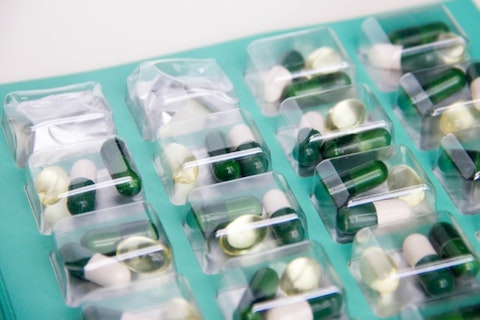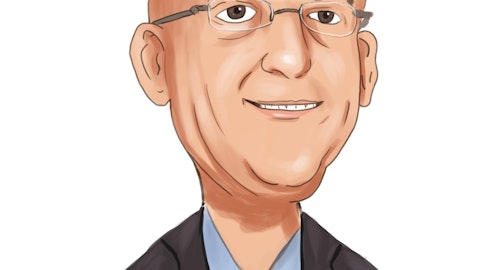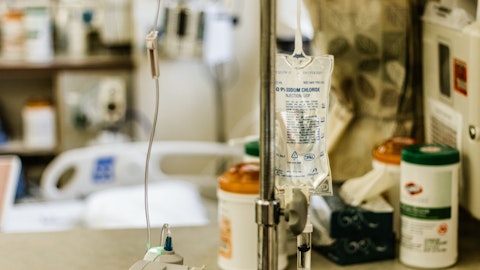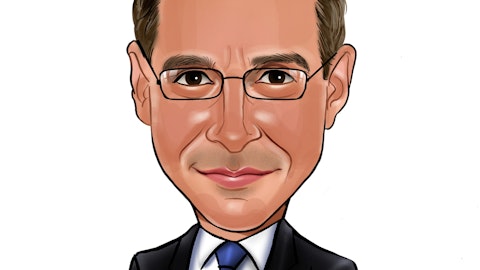Ultragenyx Pharmaceutical Inc. (NASDAQ:RARE) Q4 2022 Earnings Call Transcript February 16, 2023
Operator: Good afternoon, and welcome to the Ultragenyx Fourth Quarter and Full Year 2022 Financial Results Conference Call. It is now my pleasure to turn the call over to Joshua Higa, Executive Director and Head of Investor Relations.
Joshua Higa: Thank you. We have issued a press release detailing our financial results, which you can find on our website at ultragenyx.com. Joining me on this call are Emil Kakkis, Chief Executive Officer and President; Erik Harris, Chief Commercial Officer; Camille Bedrosian, Chief Medical Officer; Aaron Olson, Senior Vice President of Corporate Strategy and Finance; and Ted Hazinga, Chief Accounting Officer. I’d like to remind everyone that during today’s call, we will be making forward-looking statements. These statements are subject to certain risks and uncertainties, and our actual results may differ materially. Please refer to the risk factors discussed in our latest SEC filings. I’ll now turn the call over to Emil.
Emil Kakkis: Thanks, Josh, and good afternoon, everyone. Some of you may have listened in on my presentation at the recent JPMorgan Healthcare Conference where I talked about our focus for areas for 2023. Over last year, we completed several strategic investments, aligned our teams and resources around the highest value-generating programs for the company. This year, we’ll continue to focus on operational efficiency while generating data from our key clinical programs in Angelman, osteogenesis imperfecta and our pivotal gene therapy studies. In 2022, we generated more than $350 million of global revenue in our fifth year as a commercial company. This year, we expect revenue to be in the $420 million to $450 million range from our four products across five indications.
We expect a steady revenue growth to continue as the existing products are still in relatively early phases of commercialization. At the same time, the investments made over the last few years have positioned us to drive meaningful value from large opportunity programs like GTX-102 for Angelman and UX143 for osteogenesis imperfecta, and we have more recently bolstered our business with additional strategic steps. Specifically, we secured a license and collaboration agreement to commercialize Evkeeza for clinical homozygous familial hypercholesterolemia in countries outside of the US, which will leverage our global commercial infrastructure and capabilities. We acquired global rise to UX111 in AAV gene therapy for the treatment of Sanfilippo syndrome from Abeona based on the strength of the pivotal marker data and clinical data generated in the Transfer A study.
We also exercised our option to acquire GeneTx following interim data from the Phase I/II of GTX-102 for the treatment of Angelman syndrome the GeneTx acquisition gives us full control over that program. And we completed the build-out of our gene therapy manufacturing plant in Bedford, Massachusetts, which is expected to begin production this spring. This facility and our manufacturing capabilities grant us the ability to better control the timing, cost and scale of the production of our gene therapies, establishing us as a commercial-ready gene therapy company. We acquired global rise to UX111 in AAV gene therapy for the treatment of Sanfilippo syndrome from Abeona based on the strength of the pivotal marker data and clinical data generated in the Transfer A study.
We also exercised our option to acquire GeneTx following interim data from the Phase I/II of GTX-102 for the treatment of Angelman syndrome the GeneTx acquisition gives us full control over that program. And we completed the build-out of our gene therapy manufacturing plant in Bedford, Massachusetts, which is expected to begin production this spring. This facility and our manufacturing capabilities grant us the ability to better control the timing, cost and scale of the production of our gene therapies, establishing us as a commercial-ready gene therapy company. We acquired global rise to UX111 in AAV gene therapy for the treatment of Sanfilippo syndrome from Abeona based on the strength of the pivotal marker data and clinical data generated in the Transfer A study.
We also exercised our option to acquire GeneTx following interim data from the Phase I/II of GTX-102 for the treatment of Angelman syndrome the GeneTx acquisition gives us full control over that program. And we completed the build-out of our gene therapy manufacturing plant in Bedford, Massachusetts, which is expected to begin production this spring. This facility and our manufacturing capabilities grant us the ability to better control the timing, cost and scale of the production of our gene therapies, establishing us as a commercial-ready gene therapy company. We also exercised our option to acquire GeneTx following interim data from the Phase I/II of GTX-102 for the treatment of Angelman syndrome the GeneTx acquisition gives us full control over that program.
And we completed the build-out of our gene therapy manufacturing plant in Bedford, Massachusetts, which is expected to begin production this spring. This facility and our manufacturing capabilities grant us the ability to better control the timing, cost and scale of the production of our gene therapies, establishing us as a commercial-ready gene therapy company. We also exercised our option to acquire GeneTx following interim data from the Phase I/II of GTX-102 for the treatment of Angelman syndrome the GeneTx acquisition gives us full control over that program. And we completed the build-out of our gene therapy manufacturing plant in Bedford, Massachusetts, which is expected to begin production this spring. This facility and our manufacturing capabilities grant us the ability to better control the timing, cost and scale of the production of our gene therapies, establishing us as a commercial-ready gene therapy company.
Within our pipeline, we made strong progress over the past year in addition to progressing our Angelman program. We initiated a pivotal Phase II/III program for UX143 and OI and have completed enrollment of the Phase II portion of the study. We advanced DTX401 in two pivotal Phase III study for GSDIa and have enrolled the last patient into the baseline screening period. We also initiated a Phase III study of DTX301 in OTC, where we have randomized and dosed the first patient in this study with additional patients in the baseline screening period. And we initiated dose patients in the pivotal seamless study of UX701 for Wilson disease. As a commercial company with growing revenue in a diverse late-stage clinical pipeline, we recently evaluated ways to improve our operating efficiencies.
We will focus on leveraging our established global infrastructure actively managing expenses and headcount to drive value from the commercial launches and execute on our most important clinical programs. With that, I’ll turn the call over to Erik to provide more specifics on the commercial programs and their successes last year.

Photo by Simone van der Koelen on Unsplash
Erik Harris: Thank you, Emil, and good afternoon, everyone. 2022 was an important year for the commercial and field teams. Across all the products, they delivered 35% year-over-year growth overcoming some of the early challenges presented by the only ran variant. Revenue from Crysvita in our territories grew 34%; Dojolvi grew 41%; and Mepsevii, our ultrarare product grew 29%. The team’s efforts are proving rare disease products can generate meaningful revenue growth 5-plus years after launch. 2022 was also the first year where global sales of Crysvita exceeded $1 billion. Crossing the threshold we made possible through the Ultragenyx team’s efforts that led to approximately $700 million in total product sales across North America and Latin America and also the efforts of key our caring in Europe and Asia.
Since launching Crysvita in April 2018, we have established a strong base of business that we expect will continue to grow as we transition the primary commercialization responsibilities to Kyowa Kirin in April of this year. In the U.S., we added approximately 110 start forms in the fourth quarter and approximately 90 patients on reimbursed therapy, along with 50 new unique prescribers. These metrics are nearing their pre-pandemic levels and support the 26% annual revenue growth in this region. This is particularly impressive as the team has shifted efforts to finding adults into harder-to-reach community clinics where more than 50% of our start forms are generated. With combined Kyowa Kirin and Ultragenyx build teams in Q4, we have started to reach many more prescribers in the community and raising awareness of XLH, which has helped us in our patient find efforts.
In Latin America, Crysvita continues to grow, supported by additional regulatory and reimbursement approvals and also from steady demand in the pediatric and adult setting. We ended 2022 with approximately 300 patients on reimbursed therapy in this region, and we expect this will continue to grow as more and more prescribers to the benefits their patients experience from Crysvita. As is common in this region, ordering patterns drive some quarter-to-quarter variability in revenue, but the underlying demand continues to grow at a steady pace. In 2023, we updated the regions for which we will issue Crysvita guidance. This does a better job of representing the broad reach of Crysvita and the total revenue to Ultragenyx. At the beginning of the year and reaffirmed today, we issued guidance of $325 million to $340 million for Crysvita in North America, Latin America and Europe.
This is inclusive of all types of revenue, but our profit share, royalty, cash or noncash. Compared to 2022 for the same regions and types of revenue, this range represents between 16% and 22% growth. Turning now to Dojolvi, where I’ll begin with the team’s work in the U.S. In 2022, we were encouraged by truly strong patient demand. We ended the year with approximately 425 completed start forms with approximately 375 patients on reimbursed therapy. The number of unique prescribers continues to grow, now with approximately 190 health care providers writing at least one prescription for Dojolvi. In 2023, we will be focused on continuing to educate health care providers on the benefits of the dose titration supported by our clinical studies to ensure patients are able to achieve optimal dose titration.
In Europe, demand for Dojolvi continues to be led by the name patient and early access programs, particularly in France and Italy. We have also begun to see requests come in from Germany, Austria and certain Middle East countries. In Latin America, we are continuing to work through the process, leveraging our existing infrastructure to expand across the region. In Brazil, Dojolvi is currently approved, and we are working through the process to get full reimbursement approval from the Ministry of Finance. We also anticipate additional country regulatory filings in the region later this year. Across all regions, we expect 2023 Dojolvi revenue to be between $65 million and $75 million, reaffirming the range we announced last month. This represents between 17% and 35% growth over 2022.
At the beginning of the year, we also issued guidance for total revenue, which we are reaffirming today, the range of $425 million to $450 million represents 20-plus percent growth versus 2022. It includes estimates for Crysvita and Dojolvi that I just mentioned and also includes Mepsevii and Evkeeza. With that, I’ll turn the call to Aaron to share more details on the financial results for the quarter.
Aaron Olson: Thanks, Erik. Earlier today, we issued a press release that included financial results for the quarter, which I will briefly summarize. Company revenue for the 12 months ended December 31, 2022, totaled $363 million, Crysvita revenue in Ultragenyx territories was $258 million, including $215 million in the North American profit share territory and net product sales of $43 million in other regions. Total royalty revenue related to the sales of Crysvita in the European territory $22 million, Dojolvi revenue for 2022 was $56 million, Mepsevii revenue for the same time period was $21 million. Our total operating expenses for the year ended December 31, 2022, were $1 billion, which included R&D expenses of $706 million, SG&A expenses of $278 million and cost of sales of $28 million.
Operating expenses for the year include noncash stock-based compensation expense of $130 million and a onetime R&D expense of approximately $75 million related to our acquisition of GeneTx. For the year ended December 31, 2022, net loss was $707 million or $10.12 per share. We ended the year with approximately $900 million in cash, cash equivalents and marketable securities. In 2023, our net uses of cash are expected to decrease significantly as we leverage our established infrastructure and continue to grow the top line. This will be enabled by financial discipline, revenue growth and operational focus on our late-stage clinical portfolio. While these improvements in net cash use will be partially offset by the portion of our Crysvita North America royalty that will now be to our financing partner.
We are confident that the continuing strength of our business fundamentals will allow us to drive towards profitability in the coming years. Now I’ll turn the call back to Emil to read the recap the 2023 clinical catalyst.
Emil Kakkis: Thank you, Aaron. I’ll summarize the catalysts from our broad and diverse clinical portfolio before we open up for the Q&A. Starting with UX143 for osteogenesis imperfecta, setrusumab’s anti-sclerostin mechanism provides a unique dual action to address the body’s maladaptive response to the bad collagen. If unique maximum stimulates more osteoblast to mature into bone making cells and makes those cells increase their bone production while also limiting bone resorption. The Phase II portion of the study has been fully enrolled, and we expect to share these data in transition to the Phase III in mid-2023. Separately, we are playing initiate a young pediatric study that compares setrusumab to bisphosphonates to assess total fractures in a younger patient population, which have a much higher fracture frequency.
Next, GTX-102 in Angelman syndrome. We are continuing to see encouraging signs of clinical activity across the patients who have been dosed under the amended and expanded access protocols. We recently began screening patients in both expansion cohorts and expect to provide the next data update based on a larger number of patients in the program later this year. Turning to the gene therapy programs. With UX111 for Sanfilippo syndrome, we’re expecting to have a meeting with FDA in the first half of 2023 to discuss the plan to file for accelerated approval based on a biomarker endpoint. For DTX401 for GSDIa, we enrolled the last patient in the baseline screening period for the pivotal study earlier this year. Once this patient has been dosed, the 48-week clock will begin, we expect to share this Phase III data in the first half of 2024.
DTX301 for OTC deficiency dosed the first patient in the Phase III study earlier this year, we anticipate enrollment in this study will increase momentum as more patients make it through the baseline screening period. UX701 for Wilson disease enrolling patients in the dose-finding stage. We expect to be complete mid-2023 with the data on safety and initial signs of clinical activity expected in early 2024. Finally, UX053, our mRNA program for GSDIa has completed enrollment in the single ascending dose cohorts of the Phase I/II study, and we expect to have these data in the first half of 2023. Based on these analyses and other work, we’ll then review our plans for the next steps in the program. I founded Ultragenyx in 2010. 13 years later, we have four commercial products and are approaching revenue of $450 million.
We also have one of the most robust late-stage clinical pipelines in rare diseases. We’re now poised for the next phase of the company with growing revenues, fueling our development of new pipeline priorities. In the coming years, a growing revenue base, financial discipline and larger indication opportunities will allow us to reach profitability while also leading the future of rare disease medicine. With that, let’s move on to your questions. Operator, please provide the Q&A instructions.
See also 12 Best Dividend Growth Stocks with 10+% Increases and 10 Hot EV Stocks To Buy.
Q&A Session
Follow Ultragenyx Pharmaceutical Inc. (NASDAQ:RARE)
Follow Ultragenyx Pharmaceutical Inc. (NASDAQ:RARE)
Operator: Our first question comes from the line of Gena Wang from Barclays.
Gena Wang: I will ask one question each for Angelman program and also osteogenesis imperfecta. For Angelman program, what are the doses you selected for the expansion cohort A and B? And then for the osteogenesis imperfecta, in the midyear update, how would you use, first, can you remind us the 2 doses used in the obvious Phase II portion? And how would you use the biomarker response enable mineral density to establish those algorithm for Phase III portion?
Emil Kakkis: Great. Thank you, Gena. So in the Angelman, we have been, of course, evaluating higher doses and through a dose titration period. We haven’t put out what doses we are using, but we’ve established some doses that we believe have an appropriate benefit risk that we’ll be using the expansion in both loading patients and in their maintenance levels. We’ve put some information out of the range of doses that we’ve been trying, but we’ll put out more information when we have it on the exact doses we’re using. With regard to osteogenesis imperfecta, we’re comparing doses in both children from ages five to adults to 25, and we’re comparing 20 to 40. Our expectation is that the younger children may need more drug in order to get enough concentration of antibodies using pharmacokinetic analysis to achieve the optimal results.
So we’ll look at the concentrations of drug in the young and the old, and we’ll also look at the biomarkers for bone production P1NP, and we’ll have also some bone marl density data as well, and the goal is to compare those and determine do we need to use a higher concentration of drug in the younger patients to achieve the optimal effect or not? So look at this as dose tuning rather than dose finding. We know the dose. The question is do we need to go a little higher in the younger patients and — you’ll get a little read on what this drug does in young patients at that time, which I think will be more responsive patients than the older patients that have been treated before, at least our expectation based on bone disease we’ve treated in the past.
Operator: And our next question comes from the line of Chris Ramsey from Piper Sandler.
Chris Raymond: Just one question on a collaboration that I don’t think I’ve heard you guys talk about. So Enozyme today mentioned that they just started a collaboration with you guys to find misdiagnosed ENPP1 patients. It seems XLH seems to overlap maybe phenotypically with that disease. Emil, this asset would seem to be something that would, I would think, fit in within your wheelhouse developmentally. Just kind of curious if you had any thoughts on this collaboration and maybe any thoughts on the drug itself, especially in light of the data that these guys had at least top line today and how you’re thinking about this relationship going forward?
Emil Kakkis: Yes. We work with a lot of companies on the issue of diagnosis and not just other companies, we’re all trying to help find patients and share that information with each other. At this point, we are not planning on bringing any more products into our portfolio. And we continue to watch the field, including what Indesign is doing and others with regard to new opportunities for rare diseases. But at this point, we have on our plate all we need to manage and — but finding patients and working with our partners and others in the field is something we do routinely.
Operator: And our next question comes from the line of Joon Lee from Truist.
Joon Lee: With the biomarker data for setrusumab, is there a level of bone formation you wouldn’t want to exceed. Are there potential safety issues, particularly in young patients, growing bones where too much bone formation could lead to potential safety issues, maybe hearing loss, for example.





